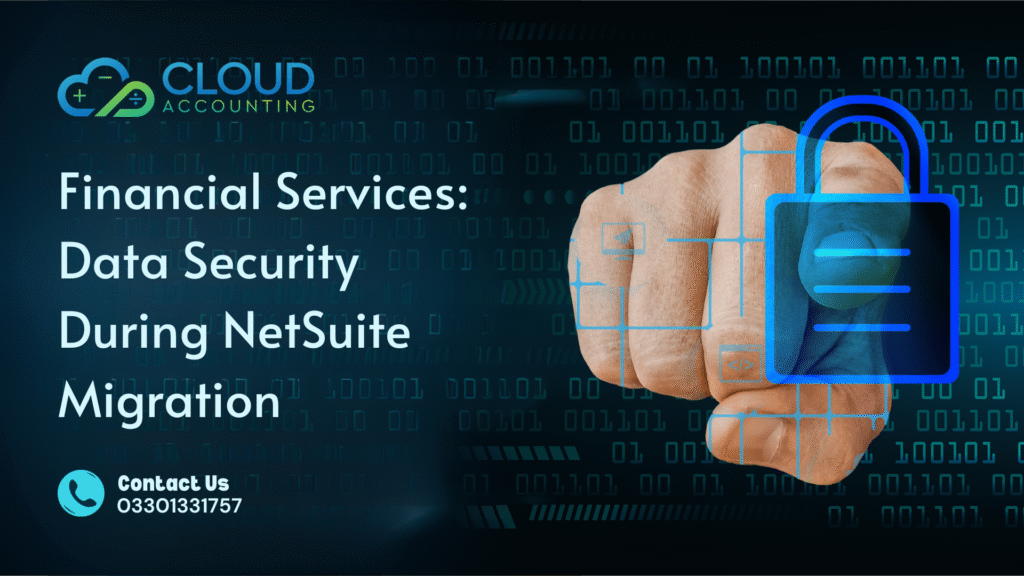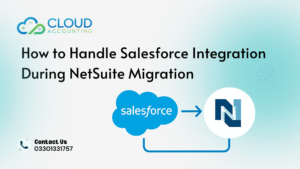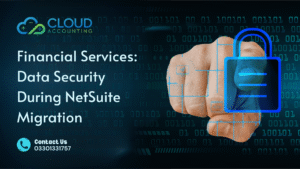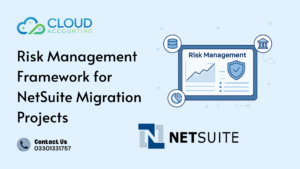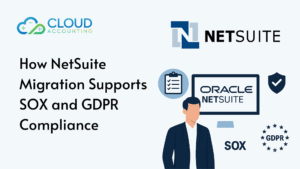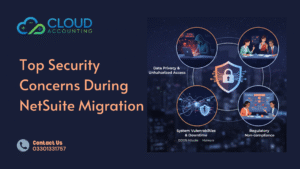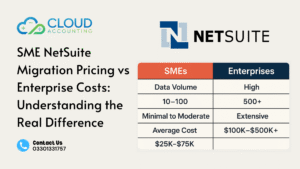When your business handles money, trust isn’t a marketing line — it’s the foundation. And when a financial services firm moves to NetSuite, that trust depends on how well the data is protected during the migration. This is why Finance NetSuite Migration Security has become one of the biggest priorities for CFOs, IT directors, and compliance teams in 2025.
With rising fraud attempts, tighter regulations, and new digital threats appearing every few months, financial businesses can’t afford weak points in their ERP transition. A single exposed file, a misconfigured permission, or an unencrypted data transfer can open the door to damaging breaches. That’s not an exaggeration — that’s the reality financial institutions are dealing with daily.
A NetSuite migration can be a major upgrade for finance teams, but only if the right security framework is built around it. In the financial sector, protecting client data, transaction records, and regulatory information isn’t optional. It’s mandatory. And the stakes are high.
In this guide, we break down the biggest risks, the smartest protections, and the steps financial leaders should take to ensure Finance NetSuite Migration Security from day one.
What Makes Finance NetSuite Migration Security Different?
When a retail or service business migrates to a new ERP, the risks are there — but they’re manageable. When a financial services company migrates, the risks multiply. That’s because Finance NetSuite Migration Security has a few unique demands that other industries simply don’t face.
First, there’s the level of sensitivity. Financial data isn’t just numbers on a spreadsheet. It’s account details, transaction histories, loan information, investment data, audits, compliance records — the kind of information cybercriminals target because it can be sold, exploited, or used for fraud.
Second, the regulatory weight behind this data is far heavier. Banks, lending companies, fintechs, brokers, and wealth management firms must comply with frameworks like PCI-DSS, SOC, GDPR, SOX, AML, and sometimes even jurisdiction-specific finance regulations. During migration, every file and workflow must meet the same standard as it does in production.
Third, the financial sector is a top target for organized cyberattacks. Hackers know migrations are ideal attack windows. Systems are in transition, teams are distracted, and data is moving. This creates opportunities for interception, spoofing, or unauthorized access if the right controls aren’t in place.
And finally, finance organizations often have complex integrations — payment gateways, banking APIs, trading platforms, loan systems — each adding another security layer to manage. These integrations can create cracks if they aren’t handled properly.
This is why financial firms can’t treat a migration as a simple data transfer. They need a hardened approach built specifically for high-risk environments.
Biggest Data Security Risks During NetSuite Migration
When financial data starts moving, the attack surface expands fast. And even well-prepared teams can miss blind spots if they’re not thinking like a security auditor. That’s why understanding the core risks is the first real step in improving Finance NetSuite Migration Security.
Unsecured data transfers are the most common weak point.
If files move between systems without proper encryption or controlled endpoints, they’re exposed. Even a short window can be enough for an interception attempt. Finance data is too valuable to leave unprotected for even a moment.
Misconfigured access is another major risk during a migration.
Temporary user accounts, elevated permissions, or open roles are often created for convenience. The problem? They’re easy to forget. One overlooked permission can create a door that shouldn’t exist.
Third-party involvement adds another layer of vulnerability.
Most financial firms rely on migration partners, consultants, or integration vendors. If even one partner uses weak security practices, your entire system is at risk. Attackers often go after the weakest link in the chain — and sometimes that link isn’t inside your company.
Integration points can also create trouble.
Finance ERPs depend on connections with banks, payment processors, trading systems, and compliance platforms. If those APIs aren’t secured during the transition, attackers can exploit them to intercept or inject data.
Outdated or incomplete backups can amplify every issue.
If something goes wrong — a corrupted file, a failed import, or unexpected downtime — firms need clean, recent, and encrypted backups. Without them, recovery turns into a scramble.
And finally, human error remains a serious threat.
Even skilled teams make mistakes when under pressure. A rushed import, a misplaced file, or a misread configuration can unintentionally expose confidential financial information.
Every risk here is preventable — but only with a well-designed security plan built around how financial institutions actually work.
How Financial Firms Can Secure Their NetSuite Migration
Once the risks are clear, the next step is building a security framework strong enough for financial data. This is where Finance NetSuite Migration Security becomes a strategic effort instead of a reactive one. With the right controls in place, financial institutions can move their data confidently without exposing sensitive information.
Start with strong encryption across every stage of data movement.
Encryption isn’t just a checkbox — it’s your shield. Use industry-standard encryption (AES-256 at rest and TLS 1.2+ in transit). Every file, every transfer, every backup should stay encrypted from the moment it leaves the source system until it lands in NetSuite. If anyone intercepts it, all they’ll see is scrambled noise.
Apply strict Identity and Access Management (IAM) during the migration.
Role-based access needs tightening, not loosening. Give users only the access they actually need — and only for as long as they need it. Multi-factor authentication should be mandatory. Temporary accounts should be monitored and removed the moment they’re no longer required.
Validate the environment before any data moves.
Your pre-migration phase should include:
- Reviewing user roles
- Checking audit logs
- Confirming data residency requirements
- Locking down integration endpoints
This step alone stops a huge portion of breaches tied to misconfigurations.
Secure the API and integration layer.
Financial firms rely on heavy integration — banks, trading systems, payment processors, regulatory platforms. Every connection needs security policies such as:
- Token-based authentication
- HTTPS-only communication
- API throttling and monitoring
A breach through an integration point is often the hardest to detect.
Establish clean, encrypted, versioned backups.
Before a single record moves, firms should have:
- A complete encrypted backup
- A test restore to prove the backup works
- Versioned snapshots for rollback
- Offsite or cloud redundancy
If anything becomes corrupted or compromised, recovery becomes a controlled step instead of an emergency.
Create a secure migration workspace.
Use a dedicated, isolated environment for staging and validating data. This workspace should:
- Restrict external access
- Block unauthorized downloads
- Keep audit logs active
- Encrypt cached data
It removes unnecessary exposure and keeps your sensitive files contained.
Train your internal team before the migration begins.
Security tools only work if the people using them know what to watch for. A short but focused training session helps employees avoid common mistakes like:
- Unsafe file sharing
- Weak temporary passwords
- Using personal devices
- Clicking suspicious links during high-activity periods
Financial data attracts criminals. A trained team is one of the best defenses.
When firms follow these steps, Finance NetSuite Migration Security becomes predictable, controlled, and strong enough to withstand both internal mistakes and external threats.
Security Measures NetSuite Already Provides (and What You Must Add)
When financial institutions plan a migration, it helps to know NetSuite isn’t starting from zero. The platform already includes strong native protections designed for high-risk industries. But relying on them alone isn’t enough. True Finance NetSuite Migration Security requires understanding what NetSuite covers — and where your team must strengthen the setup.
NetSuite’s built-in encryption handles data at rest and in transit.
This is the first safety net. NetSuite uses advanced encryption to protect stored records and secure communications. It means that once your data lands inside NetSuite, it’s already shielded from basic interception and unauthorized access.
Role-based access controls (RBAC) come standard.
NetSuite lets you create highly detailed role permissions. Finance teams can restrict users by module, function, or even specific record types. During the migration, this helps reduce unnecessary exposure — but the controls must be reviewed and tuned before any data moves.
Advanced audit trails keep everything visible.
NetSuite logs who accessed what, when they accessed it, and what changes they made. This supports SOX, GDPR, and other compliance frameworks. During a migration, the audit log becomes your early-warning system for unusual activity.
Two-factor authentication (2FA) protects user accounts.
NetSuite requires MFA for critical roles, which helps block unauthorized logins. For financial firms, enabling this across all migration accounts isn’t optional — it’s non-negotiable.
NetSuite also provides IP restrictions and device management.
These features stop unknown users or locations from accessing accounts. For firms with distributed teams, this creates a controlled perimeter.
But even with all these features, there are areas where financial institutions must take the lead.
You must manage encryption before NetSuite receives the data.
NetSuite protects data once it’s inside the system. But the migration path — CSV files, API transfers, staging environments — needs your encryption protocols. This is where many breaches happen.
You must secure your integration ecosystem.
NetSuite doesn’t control your bank feeds, trading APIs, payment processors, or loan management tools. Authentication, throttling, access limits, and endpoint security all fall on your migration strategy.
You must implement a hardened temporary access policy.
NetSuite gives you the tools, but your internal team needs to define:
- Who has access
- For how long
- With what permissions
- Under what monitoring
Financial data is too sensitive for “set it and forget it.”
You must build a secure backup and rollback plan.
NetSuite provides data redundancy, but it does not manage your pre-migration backups. You remain responsible for ensuring those backups are encrypted, tested, and easily recoverable.
Combine NetSuite’s security with your firm’s enhanced controls, and you create a layered defense strong enough for financial operations.
The Role of Cloud Accounting in Finance NetSuite Migration Security
Financial institutions don’t just need a migration partner—they need a team that understands the pressure, the regulations, and the weight behind every single data point they move. This is where Cloud Accounting becomes a core part of strengthening Finance NetSuite Migration Security.
We understand the security expectations financial firms must meet.
Banks, fintech companies, lending firms, wealth managers, and insurance providers all work under strict compliance rules. Our team maps every migration step to the exact security controls needed for audits, regulatory checks, and internal governance. Nothing moves unless the security standard is met.
We build a secure migration framework before touching your data.
Our approach begins with planning, not transferring. Cloud Accounting creates a hardened environment where all staging, validation, and testing happen under strict access control. This ensures sensitive financial data never sits exposed in emails, shared folders, or unmonitored systems.
We manage encrypted transfers from start to finish.
Many breaches happen in the “in-between”—the moments where data travels from old systems to new ones. Our team uses bank-grade encryption protocols, locked endpoints, and verified channels so financial information stays protected throughout the move.
We secure every integration point financial firms rely on.
Your business connections don’t disappear during a migration. You still depend on:
- Banking APIs
- Loan management systems
- Payment gateways
- Trading and investment tools
- Compliance and audit platforms
We assess, optimize, and secure each connection to make sure no vulnerabilities slip through during the transition.
We audit access, monitor activity, and keep the environment locked down.
During a migration, dozens of small tasks happen behind the scenes—role adjustments, data imports, test runs, integration checks. We log and verify every action so no one has more access than necessary.
We provide continuous guidance even after the migration is complete.
Security doesn’t stop once NetSuite goes live. We help financial teams review permissions, tighten controls, and adopt long-term best practices. Our goal is to leave your system stronger than before your migration began.
Financial firms trust Cloud Accounting because their data isn’t just “critical”—it’s irreplaceable. And we treat it that way from the first planning meeting to the final go-live.
Checklist :12 Must-Have Security Controls for Finance NetSuite Migration Security
Financial firms deal with sensitive, high-value information every day. During a migration, that information is at its most vulnerable. This checklist gives you the essential controls needed to strengthen Finance NetSuite Migration Security from start to finish.
1. Encrypted data exports
Every export should use AES-256 encryption before files leave the source system.
2. Secure transfer channels
Use TLS 1.2+ for API calls and approved encrypted transfer methods for files.
3. Controlled staging environment
No shared drives. Use an isolated, access-restricted, encrypted workspace.
4. Strict role-based access
Grant the minimum required permissions. Remove temporary roles immediately.
5. MFA for all migration-related accounts
No exceptions—every user with migration access should use multi-factor authentication.
6. IP
Allow migration access only from approved locations or devices.
7. API endpoint hardening
Use token-based authentication, rate limits, and HTTPS-only communication.
8. Backup verification tests
Test every backup before migration begins to confirm it can be restored.
9. Integration security review
Check banking APIs, payment gateways, and financial tools for vulnerabilities.
10. Continuous audit logging
Track every login, import, role change, and workflow adjustment.
11. Data minimization
Move only the data you need. Archive the rest securely.
12. Post-migration access audit
Once NetSuite goes live, re-check all permissions and close any temporary access.
These 12 steps form a strong defense that reduces exposure, protects sensitive financial information, and gives compliance teams the documentation they need.
Conclusion & CTA
When financial data is on the move, the stakes rise fast. A migration isn’t just a technical project, it’s a security event. That’s why firms are paying closer attention to Finance NetSuite Migration Security than ever before. The goal isn’t simply to move information from one system to another. It’s to protect client trust, meet regulatory expectations, and ensure every record arrives intact and uncompromised.
Strong security doesn’t happen by accident. It comes from planning, hardening every step of the data journey, and working with specialists who understand the financial sector’s unique risks. With the right safeguards, financial firms can migrate to NetSuite confidently, knowing their data is protected before, during, and after the transition.
Ready to safeguard your financial data during your NetSuite migration? Let our experts help you move with confidence and complete security.

